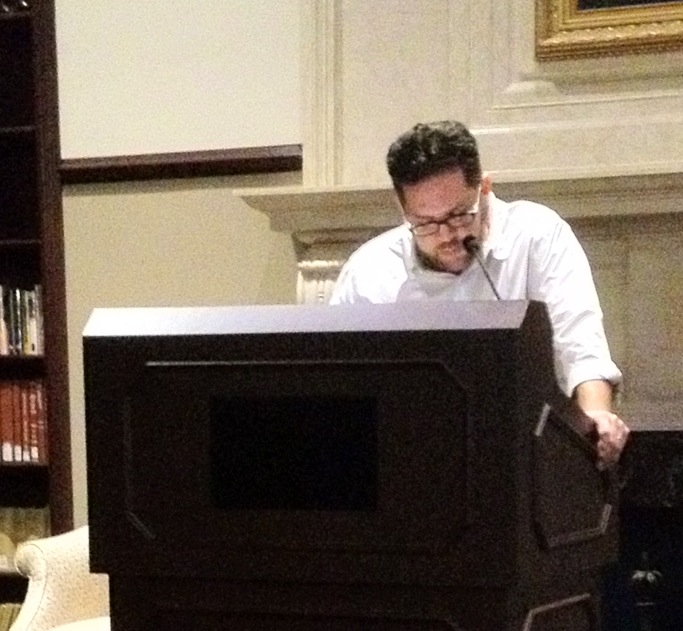
Let’s talk for a moment about Brandon Hobson. His new novel, Deep Ellum, is a short and searing look at a deeply damaged family living in Texas. Gideon, the book’s narrator, returns to his hometown of Dallas to help with a family crisis, but quickly finds himself wrestling with a host of complex relationships and impossible scenarios. It’s the kind of novel where the line between redemption and simple survival is quiet thin. (For those who might be curious, an excerpt appeared in The Literarian.) I checked in with Hobson via email to learn more about the novel’s history, its setting, and the occasional references to narwhals that occur throughout the book.
What first led you to set your novel in Dallas, and to title it for the neighborhood where it’s set?
Deep Ellum has always fascinated me. Part of it is the structure of the buildings, the history, the shadows and grittiness of the place. The ghosts of musicians there. It’s also very beautiful. There’s jazz and blues history. People like Robert Johnson and Lead Belly played there. Then there’s the famous nightclubs, the Gypsy Tea Room and Trees. What a cool, strange place. I can’t understand why more novels aren’t set there.
As for the title, the book was originally called Night Bird, based off a Chet Baker song. You’ve listened to this, no? When I think of the book I think of this tune. But Derek White and I discussed it and ultimately thought the Chet Baker reference was too obscure and that Deep Ellum was stronger.
Chet Baker’s influence definitely hangs over this book. What first drew you to his music, and when did you realize that he would suffuse this story?
I’ve liked Chet Baker’s music for a long time. I’ve been listening to him for many years. I’ve learned to appreciate jazz in general a lot more as I’ve gotten older. Tobias, have you seen the documentary about him, Let’s Get Lost? It isn’t just about the heroin. So there’s this mood, these images the music produces. I see Gideon and Meg. I see Puig, I see myself. My children, my wife. Chet Baker was born over in Yale, right here in Oklahoma. You should watch that film. It isn’t just about the heroin.
Though he doesn’t appear on many pages, the character of Warren Puig is one of the novel’s most memorable. When he’s first introduced, he opens each sentence with a positive affirmation; where did this quirk of his speech come from?
What a great question. It starts with an image of an older, eccentric man in a ratty coat. He’s a weird, lovable guy. He loves art and younger women and wine and having parties. Do you know older men like this? Warren Puig’s voice was probably the strongest in my head from the very beginning.
At a party thrown by Puig, Gideon, the novel’s protagonist, overhears fragments of several conversations, nearly all of them surreal in some way. How did you come up with these seemingly random bits of dialogue?
I don’t know about you, but I love random bits of absurd dialogue that mean nothing. Who knows where these things come from. But often I’ll think of something when I’m driving. Out here in the plains I can drive on an open highway with little traffic. I think driving is good for a fiction writer. Driving gives me time to think.
Speaking of those conversations, I’m curious: where did the thread about narwhals, which recurs throughout the novel, first begin?
This is an inside joke. The repeated dialogue, “Narwhals hide behind Dumpsters in Paseo. Spread the word,” originated from my friend Josh, who once did mushrooms and wore an eye patch at the arts festival in a district called Paseo in Oklahoma City. When someone asked him why he was wearing an eye patch, he said a narwhal jumped out from behind a Dumpster and poked him in the eye. Not ten minutes ago I texted Josh to ask if he minded that I share this, and he was cool with his name being mentioned here.
There’s a moment partway through the book where Gideon finds a selection of stories written by his sister Meg when she was a child. They are, to possibly understate the matter, unsettling. What was your process like for coming up with stories written by one character at a much younger age than the one in which we first encounter her?
Meg is a fan of fairy-tales and strange stories, so this part was fun to write. One of the things about Meg is that she’s so private and mysterious, even to Gideon, despite their close relationship. Part of finding the stories was a way for Gideon to discover that she’d been thinking about horrible things even when she was younger. I hope it was effective.
Do you view these characters’ stories as having ended on the book’s last page, or do you see certain members of this family returning in other works?
That’s a good question, Tobias. I like Meg a lot but doubt I’ll write more about her anytime soon. I have a feeling Warren Puig will show up somewhere in disguise.
Follow Vol. 1 Brooklyn on Twitter, Facebook, Google +, our Tumblr, and sign up for our mailing list.
